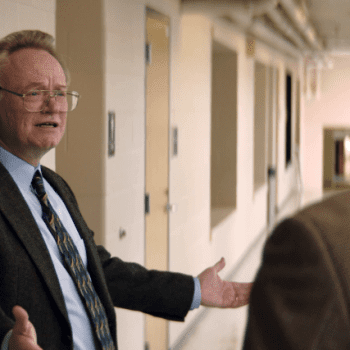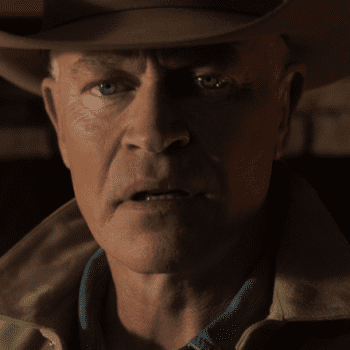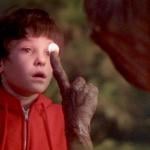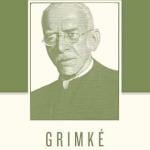Other guides: Risen (2016) | The Young Messiah (2016) | Paul, Apostle of Christ (2018)
Mary Magdalene had a brief theatrical run in North America last month and is now available via video-on-demand in the U.S. (though not in Canada, as far as I can tell), so I figured now would be a good time do a scene guide for this film, similar to the ones I have made for other recent films based on the New Testament.
Because a few scenes from the film have been made available online, I have also included those in the scene guide where appropriate.
Timecodes are approximate, based on an online screener that I watched a few times.
Before I get into the scene-by-scene analysis, a few preliminary comments:
First, there isn’t a whole lot about Mary Magdalene in the canonical gospels. There have been many wild legends about Mary over the years — from the western tradition that she was a reformed prostitute to the modern myth that she was Jesus’ secret wife — but, as E.P. Sanders once put it (in his 1993 book The Historical Jesus), for all our sources tell us, she could have been “eighty-six, childless, and keen to mother unkempt young men.”
So, any film about Mary Magdalene’s life is going to be highly speculative and essentially fictitous. A “midrash”, if you will, to use a word that has come up with other creative attempts to fill the gaps in the scriptures, such as Darren Aronofsky’s Noah.
Here is what the gospels do tell us about Mary Magdalene: She was one of “many” women who traveled with Jesus and cared for his needs (Mark 15:41, Luke 8:1-3). Luke also says that these women — one of whom was married to the manager of Herod Antipas’s household — supported the Jesus movement “out of their own means,” which suggests that Mary and the others were patrons with significant financial resources, similar to the women who helped support the spread of the early church in the book of Acts. The movie, however, depicts Mary as a poor woman who has no resources of her own, other than the emotional support that she gives to Jesus and some of his followers.
Luke also states that Jesus cast seven demons out of Mary, and all four gospels agree that she was one of several women who witnessed the Crucifixion and the empty tomb — but I’ll get to those passages when we get to the equivalent scenes in the film.
And now, the scene-by-scene analysis:
01:15-03:15 — Prologue
The film begins with images of Mary floating underwater and rising to the surface — an activity that, in a later scene, she will associate with the feeling of being one with God.
As she swims, Mary’s voice is heard in a voice-over, stating: “And she asked him, ‘What will it be like, the Kingdom?’ And he said, ‘It is like a seed, a single grain of mustard seed, which a woman took and sowed in her garden, and it grew and it grew, and the birds of the air made nests in its branches.’ ”
Versions of this parable are told in three gospels (Mark 4:30-32, Matthew 13:31-32, Luke 13:18-19), but none of them have the female element that the movie version has. The opening question is asked by Jesus himself, rhetorically, in Mark and Luke, and there is no opening question in Matthew. Also, Mark’s version of the parable does not say who planted the seed, while the versions in Matthew and Luke both say it was planted by a man.
Aside from that, the movie version of the parable is closer to Luke’s version than the others. Mark and Matthew both emphasize that the mustard seed is the smallest of all seeds and that the mustard tree is “the largest of all garden plants”, but the movie, like Luke’s gospel, leaves out those details. Also, Mark’s version says the birds perched in the tree’s shade, while Matthew and Luke, like the film, say the birds perched in its branches.
A title card sets the film in “Judaea, 33 CE.” The date presumably stems from the traditional belief that Jesus was 33 years old when he died (which, in turn, stems from Luke 3:23’s statement that Jesus was “about thirty” when he began his ministry, and from John’s indication that Jesus’ ministry lasted at least three years, because of how often he takes part in the Passover and other religious festivals within that gospel). However, if Jesus was born before the death of Herod the Great, as the gospels say (Matthew 2:1-20, Luke 1:5), then he had to be born no later than 4 BC, and he would have been in his mid- to late 30s by AD 33.
The title card also says, “The Roman Empire has appointed a puppet ruler, Herod Antipas, to govern the Jewish people.” This is a bit oversimplified. The kingdom of Judea was divided into multiple jurisdictions after Herod the Great’s death, and his son Antipas was put in charge of Galilee, which is where Jesus and most of his earliest, closest followers came from. The province of Judea itself — the jurisdiction that kept the name of Herod’s kingdom — was given to one of Herod’s other sons but, by the time this movie takes place, it was governed directly by the Romans under Pontius Pilate.
03:15-07:00 — Mary helps a woman give birth
This scene establishes Mary’s compassion, and also the fact that women aren’t allowed to do much more than marry and have children within this culture. (When one woman praises Mary’s skill and calls her “a natural” at midwifery, the baby’s father replies, “Aren’t you all?”)
Also, the eye contact Mary makes with the pregnant woman as she lies down next to the woman prefigures the eye contact that Jesus will make with the man that he raises from the dead in a later scene.
07:00-08:55 — Mary goes to the synagogue
The men and women sit on opposite sides of the synagogue and pray in Hebrew. (Presumably all of the English dialogue is “really” being spoken in Aramaic.) I can’t make out all of the Hebrew prayers, but they do include the Shema, a passage from Deuteronomy 6:4 that is one of the most important prayers in Judaism, and which Jesus himself said was the first and greatest commandment (Mark 12:29-30; cf. Matthew 22:37-38, Luke 10:25-28).
08:55-09:45 — Mary’s father arranges a marriage for her
Mary’s father says, “I lift up my eyes to the mountains,” and Mary replies, “From where will my help come.” They are quoting Psalm 121:1 (in English/Aramaic, not Hebrew!).
09:45-12:40 — Mary’s family sets her up with a potential husband
Mary’s brother has heard Jesus preach and has seen him heal a man “by the beacon.” The man in question was known for shouting all the time, and the brother says a demon may have been cast out of him. This does not seem to be tied to a specific exorcism story in the gospels, though there are many references to exorcism in the gospels of Mark, Matthew and Luke. (Interestingly, Jesus does not perform any exorcisms in John’s gospel.) The closest thing to a man who shouted all the time in the gospels might be the demoniac who was healed in a synagogue in Capernaum (Mark 1:21-28, Luke 4:31-37).
One of Mary’s kinswomen says John the Baptist was a true prophet, and that’s why he was killed. John’s death is mentioned in three gospels (Mark 6:14-29, Matthew 14:1-12, Luke 9:7-9), and is also mentioned by the first-century Jewish historian Josephus (The Antiquities of the Jews 18.2), who reports that John was still highly regarded by the Jewish people long after his death.
12:40-15:05 — Mary rejects her arranged marriage
15:05-20:00 — Mary’s family responds
Mary’s brother says she could pray whenever or wherever she wants if she were a man, but as it is, she must pray in the synagogue only at appointed times, with the women, or at home with her family.
Mary’s family arranges for an exorcism in the middle of the night, which involves dunking her underwater. In this, it prefigures baptism, but in a bad way.
20:00-23:10 — Mary’s family summons Jesus
Mary’s family tells Jesus she has “a demon,” singular, but Jesus — after recognizing that Mary is a kindred spirit who has felt God’s presence — concludes that “there are no demons here.” The biblical Jesus, on the other hand, cast seven demons out of Mary (Luke 8:2).
23:10-31:15 — Mary watches Jesus and his followers
Jesus says, “God’s kingdom is taking root, so we must prepare.” The imminent arrival of God’s kingdom is implicit in passages such as Mark 1:15, where the first words the biblical Jesus preaches are: “The time has come. The kingdom of God has come near. Repent and believe the good news!” But the notion of preparation is more commonly associated with John the Baptist, who told people to “repent” to “flee the coming wrath” (Matthew 3:7-8, Luke 3:7-8); the angel who announced John’s birth also predicted that John would “make ready a people prepared for the Lord” (Luke 1:17).
Jesus says, “You must wash away the stains of your corruption and be born anew, like children.” The biblical Jesus said “no one can see the kingdom of God unless they are born again” (John 3:3-8). He also said that “anyone who will not receive the kingdom of God like a little child will never enter it” (Mark 10:13-16, Luke 18:15-17; cf. Matthew 18:3-5, 19:13-15).
Jesus says the people have been hiding “behind the semblance of your faith. You recite your psalms and present your sacrifices as if your hearts and spirits, your service to God, were what? And afterward you go back to your lives and do what pleases you, what suits you, what makes the days upon this Earth pass easily for you. Like dreamers. But wake up, Magdala! Open your eyes. Look at the people of Galilee and Judea, suffering, crying out for help, for mercy, for justice.” The biblical Jesus quoted passages from the Old Testament about God desiring mercy, not sacrifice (Matthew 9:13, 12:7; cf. Hosea 6:6), and about people honouring God with their lips but not their hearts (Mark 7:1-23, Matthew 15:1-20; cf. Isaiah 29:13, Luke 6:43-45). The biblical Jesus also commended a teacher of the law for saying that loving God with all one’s heart was “more important than all burnt offerings and sacrifices” (Mark 12:28-34; cf. Deuteronomy 6:5, Matthew 22:34-40, Luke 10:25-28), and he condemned other teachers of the law for neglecting “justice, mercy and faithfulness” in favour of empty, outward rituals (Matthew 23:23-28). The biblical Jesus also emphasized the importance of forgiving people “from your heart” (Matthew 18:35), complained that his listeners did not have the love of God in their hearts (John 5:42), and was both “angry” and “deeply distressed” at the “stubborn hearts” of those who thought it was not lawful to heal people on the Sabbath (Mark 3:5).
The disciples baptize people while Jesus preaches and heals people. Interestingly, despite the fact that the Jesus movement came after John the Baptist’s movement, which practiced baptism (obviously), and despite the fact that it came before the Church, which has also always practiced baptism (going all the way back to Peter’s first sermon in Acts 2:38-41), only one gospel mentions that baptism was practised by the Jesus movement itself in-between those two points. John 3:22-26 seems to indicate that Jesus himself was baptizing people — that is what John the Baptist’s disciples claimed, at any rate — but John 4:1-2 clarifies that it was the disciples of Jesus, and not Jesus himself, who did the actual baptizing.
Incidentally, the characters in this film all speak with a variety of accents, but Peter’s stands out in particular. The London-born actor who plays him, Chiwetel Ejiofor, speaks with a British accent in interviews and the like, but in the film he adopts a sort of quasi-African accent that sets Peter apart from the other disciples — which is striking, as the biblical Peter is the only person whose accent is even mentioned in the New Testament, and it is said that his accent gave away the fact that he was a Galilean just like Jesus and the other disciples (Matthew 26:69-75).
Jesus licks his thumbs and places them on a blind woman’s eyes, to heal her sight. The biblical Jesus healed one man by spitting directly onto his eyes (Mark 8:22-26), and he healed another man by spitting on the ground and putting the mud on the man’s eyes (John 9:1-7). He also used spit when healing a deaf and mute man (Mark 7:31-37). Reportedly, the script for this film originally called for Jesus to rub mud on the woman’s eyes, but Joaquin Phoenix, the actor who plays Jesus, refused to do that because he believed having mud in one’s eyes would be “a horrible introduction to seeing.” So the miracle in the film is arguably closer to the miracle in Mark’s gospel than the one in John’s gospel. (Incidentally, there is at least one report of someone being healed with spit in the pagan literature of the time, too. Tacitus, writing circa AD 100, says the Roman general Vespasian, who led the Romans in their first big war against the Jews, healed a blind man with his spittle while waiting in Egypt for a boat that would take him back to Rome, where he became Emperor in AD 69 (Histories, 4.81).)
After the blind woman is healed, people in the crowd shout that Jesus is “the Baptist, raised from the dead!” The biblical Jesus was indeed thought by some to be John the Baptist, or perhaps one of the Old Testament prophets (Mark 6:14, 8:27-28; Matthew 16:13-14; Luke 9:7-9, 18-19). Herod Antipas, the man who actually ordered the execution of John the Baptist, also speculated that Jesus might be John raised from the dead (Mark 6:16, Matthew 14:1-2).
Jesus goes limp and faints after performing his miracle. There is no precise precedent for this in the gospels, but something like it could perhaps be extrapolated from the story in which Jesus felt power go out of him when a woman touched the edge of his cloak and was healed (Mark 5:25-34, Luke 8:43-48).
Someone else in the crowd exclaims that Jesus is doing “the devil’s work.” The biblical Jesus was indeed accused of getting his power — including the power to perform exorcisms, which the film does not explicitly depict — from demons (Mark 3:22-30; Matthew 9:34, 12:24-28; Luke 11:15-20; cf. John 7:20, 8:48-53, 10:19-21).
As the scene continues, some of the male disciples, such as Peter, seem oblivious to what is happening to Jesus and are intent on baptizing more people, while only Mary expresses concern for Jesus himself. In this as in other scenes, the film creates the impression that the male disciples have objectified Jesus — not least in the sense that they see him as a means to achieving their religious or political objectives — while Mary connects with Jesus on a more subjective level, identifying with him as a fellow human being.
31:15-37:30 — Mary joins the Jesus movement
When Mary reveals that she is going to join the Jesus movement, her sister warns her about “all those men with him.” It appears that the Jesus of this film has not yet attracted any of the female followers that Luke 8:1-3 and other passages talk about.
Mary’s father asks Jesus, “Would you separate a daughter from her father? Is that God’s way?” Jesus replies, “Daughters from fathers. Sons from mothers.” This is a slight twist on the biblical Jesus’ statement, quoting or paraphrasing Micah 7:6, that he came to turn sons against fathers and daughters against mothers (Matthew 10:34-37, Luke 12:51-53).
Jesus baptizes Mary. As noted above, while John 3:22-26 seems to indicate that Jesus himself baptized his followers, John 4:1-2 specifies that it was only the disciples, and not Jesus himself, who did the actual baptizing.
As Jesus baptizes Mary, he says, “I baptize you with water to cleanse you. I baptize you with light and with fire. I baptize you to be born anew, awake, and ready for the day to come.” In some ways, Jesus’ words here echo the themes of John the Baptist’s ministry, but the bit about baptizing “with light and with fire” recalls John’s prediction that the one who came after him — i.e. Jesus — would baptize people “with the Holy Spirit and fire” (Matthew 3:11, Luke 3:16).
37:30-42:00 — Mary gets to know the disciples
Judas says Jesus is talking to the angels. Interestingly, while there are many stories in the New Testament about angels appearing to other people before Jesus’ birth and after his resurrection and ascension, there are no detailed stories of angels appearing to Jesus himself, and no references at all to Jesus interacting with angels during his active ministry. There are passing references to the angels who “attended” Jesus after his temptation in the wilderness before his ministry (Mark 1:13, Matthew 4:11), and there is a brief reference to an angel who “strengthened” Jesus on the night that he was arrested at the end of his ministry, after he had made his last public appearance (Luke 22:43), and that’s it.
Judas tells Mary about Peter’s son. The New Testament tells us about two of Peter’s relatives: his wife, who traveled with him on his missionary journeys (I Corinthians 9:5), and his mother-in-law, who was healed by Jesus (Mark 1:29-31, Matthew 8:14-15, Luke 4:38-39). It doesn’t tell us anything about his children, though an ancient tradition does say he had a daughter. The film, however, doesn’t mention any of these female relatives of Peter’s; instead, it invents a male relative, to underscore the association it makes between Peter and masculinity. Contrast that with the film’s depiction of Judas, who is made more sympathetic than usual partly because he is mourning the loss of his wife and daughter, i.e. the loss of his female family members.
Judas says he is waiting for the Resurrection, “when the dead, the beloved dead, will rise up and walk amongst us.” The Jewish belief in the resurrection of all Israel (and possibly all humans) at the end of the present age can be traced back at least as far as Isaiah 26:19, which was written in the 8th century BC, though it was by no means a universally held belief in Jesus’ day; Matthew 22:23 and Acts 23:6-8 both note that the Sadducees, who were very influential within the priestly class, did not believe in the resurrection. However, belief in the resurrection was taught by the biblical Jesus (Matthew 22:29-32) and by Paul (Acts 24:15), who wrote that the resurrection of all people had begun with Jesus but would not end there (I Corinthians 15:20-24).
Judas says that if Jesus simply “say[s] the word” and “lift[s] his hand,” then “the seas will part, the Roman palaces will crumble, and the heavens will rain down blood on the oppressors.” The biblical Jesus does indicate that he could summon immediate help from the heavens if he wanted (Matthew 26:53). As for the particular kind of help that Judas imagines here, the imagery is taken from texts outside of the gospels. For example, the parting seas hark back to the crossing of the Red Sea under Moses (Exodus 14:21-22) and to the way the Jordan River parted for Joshua (Joshua 3:14-17), Elijah (II Kings 2:8) and Elisha (II Kings 2:13-14). And Revelation 8:7 talks about blood raining down from heaven mixed with hail and fire.
One disciple asks, “How many men have cried ‘The coming of the Kingdom!’ and found their fate lay on the execution block?” His caution echoes that of Gamaliel, who reminded his fellow Jewish leaders that many would-be messiahs had been caught and killed (Acts 5:34-39).
Mary says, “The prophets spoke of peace, a prince of peace.” She is alluding to Isaiah 9:6.
42:00-45:40 — Mary speaks to Jesus
Mary asks Jesus “what it feels like to be one with God,” and Jesus replies that no one has ever asked him that before. Again, the film contrasts the mutual and spiritual subjectivity of the Jesus-Mary relationship with the male disciples’ tendency to treat Jesus as a means to achieving some sort of this-worldly objective.
The disciples pray in Hebrew. Interestingly, Jesus and Mary do not pray in this scene, but exchange glances, perhaps connecting with each other over their shared closeness to God — a closeness that may or may not render prayer superfluous. The biblical Jesus did pray regularly during his ministry, sometimes in isolation from the disciples and his other followers (Mark 1:35-37, 6:45-46; Matthew 14:22-23; Luke 5:16, 6:12, 9:18,28-29, 11:1-4, 22:32).
45:40-51:10 — Jesus speaks to the women of Cana
Jesus and his followers arrive in Cana. The biblical Jesus performed his first two miracles in (or from) Cana: turning water into wine at a wedding (John 2:1-11), and healing a royal official’s son from a distance, without even meeting the son in question (John 4:46-54).
Jesus makes a point of speaking to some women in response to Mary’s prodding. The biblical Jesus also sometimes took his cue from women, e.g. when his mother asked him to help with the wine supply at the wedding in Cana (John 2:1-11), or when a Canaanite woman insisted that he cast a demon out of her daughter despite his initial refusal to do so (Mark 7:24-30, Matthew 15:21-28).
The women ask who they should obey when their husbands and fathers’ wills clash with the will of God, and Jesus says they must follow God. This puts an interestingly gender-specific spin on the biblical Peter’s line that “we must obey God rather than men” (Acts 5:29).
One woman describes how a friend of hers was raped and drowned after she was caught cheating on her husband. Rape is never mentioned in the canonical gospels, however the concept of sexual violence as a punishment for sexual promiscuity does come up in the final book of the New Testament (Revelation 2:20-23; cf. Revelation 17:16).
Jesus says “there is no other way to enter the Kingdom of God” but to forgive. The link between forgiveness and the Kingdom of God (or the Kingdom of Heaven) is made most explicitly perhaps in the Parable of the Unmerciful Servant (Matthew 18:21-35; cf. Luke 17:3-4). The biblical Jesus also said that God will not forgive people their sins if those people do not forgive the sins of others (Matthew 6:14-15).
Mary baptizes the women. These appear to be the first female followers that the Jesus of this movie has, and they all appear to be relatively marginalized, socially. The gospels do not say when women began to follow Jesus in significant numbers, however they do say that Jesus had “many” female followers, some of whom were apparently fairly well-to-do patrons of his movement (Mark 15:41, Luke 8:1-3). Also, a significant number of the biblical Jesus’s followers had been “cured of evil spirits and diseases” by him, but the women who follow Jesus en masse in the film are responding simply to his preaching. (The blind woman healed by Jesus in an earlier scene does not appear to have become one of his followers, per se.)
51:10-55:55 — Jesus raises a man from the dead
Jesus raises a man from the dead. The biblical Jesus raised three people from the dead, two of whom were men, and the resurrection scene in this film has elements of both stories. As in the story of the widow’s son in Nain (Luke 7:11-17), the body has not been buried yet, and Jesus does not seem to know the dead man or his relatives. But as in the story of Lazarus (John 11:1-44), the resurrection is preceded by one of the female relatives telling Jesus he is “too late” to heal the dead man. Also, the resurrection scene takes place almost exactly halfway through the film, and will be followed very soon by Jesus’ fateful visit to Jerusalem, just as the raising of Lazarus takes place halfway through John’s gospel and is the last major act of Jesus’ public ministry before the Jewish authorities begin conspiring against him (John 11:45-57).
Jesus raises the dead man by lying down next to him, similar to how Mary lay down next to the pregnant woman as she was giving birth in the movie’s opening scene. This is similar, but not quite identical, to how Elijah and Elisha stretched themselves out over the bodies of dead young men in order to raise them back to life (I Kings 17:17-24, II Kings 4:32-37).
Peter responds to the resurrection by saying, “Now I know that you are the Son of God!” This is similar to the response of the boy’s mother after he is raised by Elijah (I Kings 17:24). The biblical Peter also declared, privately, that Jesus was “the Messiah, the Son of the living God” (Matthew 16:13-20; cf. Mark 8:27-30, Luke 9:18-20).
Peter adds, “And the people will shout it from the rooftops!” The biblical Jesus told his disciples to proclaim from the roofs what they had heard in secret (Matthew 10:27, Luke 12:3).
Mary sees Jesus stagger off as Peter keeps talking. This may parallel the way the biblical Jesus tended to withdraw from the crowds after performing some of his bigger miracles, such as the feeding of the five thousand (Mark 6:30-46, Matthew 14:13-23, John 6:1-15; cf. Luke 9:10-18). It also reflects the film’s recurring depiction of Mary as someone who pays attention to Jesus as a person while Peter and the other disciples keep trying to leverage the miracles performed by Jesus, as current ministry jargon might put it.
55:55-58:15 — Mary consoles Jesus
Jesus indicates to Mary that he had a vision of his death when he raised the dead man — and he indicates this only to Mary. The biblical Jesus, on the other hand, told his disciples about his upcoming execution (and resurrection) on multiple occasions, though the disciples did not understand what he was saying (Mark 8:31-33, 9:30-32, 10:32-34; Matthew 16:21-23, 17:22-23, 20:17-19, 26:1-2; Luke 9:21-22,43-45, 18:31-34; John 12:23ff).
58:15-1:02:10 — Jesus teaches the Lord’s Prayer
Jesus teaches his followers the Lord’s Prayer on the outskirts of a city. There are two versions of the prayer in the gospels, the more famous of which is part of the Sermon on the Mount (Matthew 6:9-13). The other version is taught to the disciples immediately after they see Jesus praying and they ask him to teach them how to pray too (Luke 11:2-4).
Jesus says he is teaching his followers how to pray “the prayer of the Baptist.” In Luke’s gospel, the disciples mention that John the Baptist taught his own followers to pray, and they ask Jesus to teach them how to pray too, but the prayer that Jesus gives them is not identified as one of John’s prayers per se.
Jesus says the prayer he is giving his followers “is the prayer of the humble, and the meek, and the poor in spirit, and those who hunger to know God’s true Kingdom, the Kingdom which will be yours in the days to come.” These words echo the Beatitudes, the passage in which Jesus says the “poor in spirit”, the “meek”, those who “hunger and thirst for justice” and others are “blessed” and will have a great “reward in heaven” (Matthew 5:3-12; cf. Luke 6:20-23).
The prayer Jesus recites in the film (“Lord, hallowed be your name, your kingdom come, give us today the bread of tomorrow, and forgive us our debts for we forgive everyone who is indebted to us. And do not bring us to the test. Amen.”) is closer to Luke’s version than the more famous one in Matthew; it leaves out the reference to God being “in heaven”, and it leaves out the request that we be delivered from the evil one. However, like Matthew’s version, it asks God to forgive us our “debts” rather than our “sins”. Curiously, the prayer in the film begins by addressing God as “Lord,” whereas both versions in the gospels address God as “Father,” and many commentators have seen the intimate parental relationship between God and his children as a significant theme in Jesus’ teaching. Perhaps “Father” was too masculine for such a feminist film.
Jesus tells Peter to send the apostles out “to preach, heal, spread the message as if I were with you,” and he tells Peter to take Mary with him. The biblical Jesus did, in fact, send the Twelve out, two by two, to spread the gospel and perform healings while he was still engaged in his public ministry (Mark 6:7-13, Matthew 10, Luke 9:1-6) — a fact that has been reflected in only a few other Jesus movies, such as Roberto Rossellini’s The Messiah. The biblical Jesus also sent out a much larger group of at least seventy followers, two by two, to preach and perform exorcisms (Luke 10:1-24). The gospels do not specify whether any women took part in these activities.
1:02:10-1:09:55 — Peter and Mary in Samaria
Peter and Mary go to Samaria. The biblical Jesus actually told the apostles to avoid Gentiles and Samaritans when he sent them out two by two — they were to minister to “the lost sheep of Israel” instead (Matthew 10:5-6). Jesus was welcomed by one Samaritan town early in his ministry (John 4:4-42), but he and his disciples avoided another Samaritan town towards the end of his ministry because of the opposition they encountered there (Luke 9:51-56).
Peter and Mary discover many wounded and sick people who have been left behind by the Romans. Mary tends to them with her compassion, while Peter is more interested in finding and baptizing people who can join the Jesus movement. Once again, Mary’s ability to interact with people subjectively is contrasted with Peter’s objectifying of other people.
Peter recalls how Jesus recruited him to be part of his ministry: “He called my name. That’s all. And it was like everything that I had in my life, they were like those pictures painted on glass, and he became the only real thing in the world.” Mark 1:16-18 and Matthew 4:18-20 give one the impression that Peter (and his brother Andrew) dropped their nets and followed Jesus immediately the first time they saw him. But Luke 4:38-5:11 indicates that the process was more gradual — first Jesus healed Peter’s mother-in-law, and then he borrowed Peter’s boat to do some preaching a few days later, and then he gave Peter a miraculous catch of fish, etc. — and John 1:35-42 says Peter was introduced to Jesus by Andrew, who had met Jesus through John the Baptist.
Notably, Peter got the name “Peter” from Jesus himself (Mark 3:16, Luke 6:14, John 1:42). His birth name was Simon. So if the first word Jesus spoke to Peter was his name, he probably addressed him as “Simon” first.
1:09:55-1:14:05 — Mary meets Jesus’ mother
Jesus and his entourage meet his mother on the road to Jerusalem. The film never mentions any of Jesus’ other relatives, such as his sisters or brothers (e.g. Mark 3:31-32, 6:3; Matthew 12:46-47, 13:55-56; Luke 8:19-20; John 2:12, 7:1-10; Acts 1:14; I Corinthians 9:5).
Jesus’ mother says he used to cry all night when he was little “because his friends said he had the devil in him.” This parallels comments that some people in the crowd at Magdala made after Jesus healed the blind woman in an earlier scene. The New Testament says nothing about Jesus’ childhood except that he went on a pilgrimage to Jerusalem when he was 12 years old and that he stayed behind in the Temple without telling his parents (Luke 2:41-52). However, there are apocryphal traditions in which the young Jesus performs a variety of miracles and even strikes some people dead; see my scene guide for The Young Messiah for more information about that.
1:14:05-1:23:25 — Jesus arrives in Jerusalem
Jesus and his followers walk into the city, some of them waving palm branches. The biblical Jesus rode a donkey into the city (Mark 11:1-10, Matthew 21:1-11, Luke 19:28-40, John 12:12-16) as a conscious fulfillment or evocation of a prophecy in Zechariah 9:9.
Jesus heads straight for the Temple as soon as he arrives in the city and causes a disturbance there. Three of the canonical gospels place this disturbance at the end of Jesus’ ministry, just like the film does (Mark 11:15-19, Matthew 21:12-17, Luke 19:45-48); the fourth places it at the beginning of his ministry (John 2:13-17).
In the film, the “cleansing” of the Temple happens immediately after Jesus comes into the city. One could certainly infer that from Matthew and Luke’s gospels, but Mark 11:11-17 says the “cleansing” took place the day after Jesus rode the donkey into the city. On the day of the donkey-riding itself, Jesus only “looked around at everything” in the temple courts.
Peter can be overheard saying, “He said, ‘I will baptize you with water, but he will baptize you with spirit…’ ” Peter is quoting or paraphrasing what John the Baptist said in Mark 1:8, Matthew 3:11 and Luke 3:16; cf. John 1:26-34.
Jesus sees blood on the priests’ robes and has flash-forwards to his crucifixion. This sequence stands out for two reasons: one, because it is still fairly rare for films to take us into the mind of Jesus through point-of-view shots, dream sequences and similar subjective cinematic techniques; and two, because most of the rest of this film tells the story from Mary Magdalene’s point of view.
Jesus confronts a priest and says, “My house shall be a house of prayer for all nations.” He is quoting Isaiah 56:7, just as the biblical Jesus did in Mark 11:17 (cf. Matthew 21:13 and Luke 19:46, which also quote Isaiah but leave out the part about “all nations”).
Jesus says, “This is a marketplace, a place to buy God’s forgiveness with a dove or a lamb.” The biblical Jesus complained that the Temple had become a “market” in John 2:16, and the other gospels note that Jesus drove out the people who were buying and selling there.
Jesus says, “God’s kingdom is not to be bought and sold!” The biblical Peter says something very close to this when Simon the Magician tries to buy the gift of the Holy Spirit some time after he hears Philip preach about the Kingdom of God (Acts 8:9-24).
As the priests grab Jesus, he shouts, “Not one stone of this place will be left! It will all be torn down!” The biblical Jesus says this to his disciples as they are admiring the Temple’s architecture in Mark 13:1-2, Matthew 24:1-2 and Luke 21:5-6. The Temple was destroyed by the Romans about 40 years later, in AD 70, though one section of it — the Western Wall — remains standing to this day and is one of the holiest sites in Judaism.
1:23:25-1:29:25 — The post-cleansing aftermath
Peter says, “We will keep Passover here tonight.” This seems to indicate that, in the film, the Passover and the “cleansing” of the Temple are both happening on the same day that Jesus came to Jerusalem. But the gospels all place the Passover several days after Jesus arrived in Jerusalem, though they disagree on when, exactly, it took place.
As noted above, Mark 11:12-19 indicates that the “cleansing” of the Temple took place one day after Jesus came to Jerusalem. Mark 11:20ff then describes what Jesus did the day after that. And then Mark 14:1 says the Passover was still two days after that. So, in Mark’s gospel, the Passover was four days after Jesus arrived in Jerusalem.
Matthew’s gospel does not specify when the “cleansing” of the Temple took place, but it does agree with Mark that Jesus taught in the Temple courts the day after that (Matthew 21:18ff), and that the Passover took place two days after that (Matthew 26:2).
Luke’s gospel is less precise but also indicates that Jesus spent multiple days in the Temple between the “cleansing” and the Passover (Luke 19:47, 21:37-38).
John’s gospel indicates that the Passover was five days after Jesus arrived in Jerusalem. John 12:1 says Jesus arrived in Bethany “six days before the Passover,” and then John 12:12-16 says Jesus rode the donkey into Jerusalem “the next day.”
The film also indicates that the Last Supper was a Passover meal. This is how the Last Supper is depicted in three of the gospels (Mark 14:12-16, Matthew 26:17-19, Luke 22:7-13); however, in John’s gospel, the Last Supper takes place the night before the Passover (John 13:1; cf. John 18:28, where the Passover still hasn’t happened yet after Jesus is arrested).
The disciples in the film seem to be walking down to the room where they will celebrate the Passover. The biblical disciples gathered in an “upstairs” room (Mark 14:15, Luke 22:12).
Mary washes Jesus’ feet just before the Last Supper. This is curious, and perhaps runs counter to the filmmakers’ stated intentions, for three reasons:
First, the biblical Mary Magdalene did not wash Jesus’ feet, but western Christian tradition has tended to conflate her with the unnamed “sinful woman” — often assumed to be a prostitute — who washed Jesus’ feet with perfume in Luke 7:36-50. The makers of this film have insisted that they wanted to liberate Mary Magdalene from her post-biblical association with that story, but this scene risks perpetuating that association (especially in light of Jesus’ dialogue, which resembles what the biblical Jesus said when the “sinful woman” washed his feet; see below for more on that).
Second, another Mary, the sister of Lazarus, washed Jesus’ feet with expensive perfume the day before he rode the donkey into Jerusalem (John 12:1-8). Including that foot-washing story could have given the filmmakers another opportunity to explore the role that a wide range of women — rich and poor, old and young, single and married — played within the Jesus movement. But the film ignores the sister of Lazarus, the same way it ignores the other female patrons mentioned in Luke 8:1-3, to keep its focus narrowly on Mary Magdalene, which creates the impression that Jesus had only one significant female follower — and this, in turn, arguably undermines the filmmakers’ efforts to put a more female-inclusive spin on the Jesus story.
Third, the only foot-washing that happened on the night of the Last Supper in the biblical account was performed by Jesus himself, to show the disciples how to be each other’s servants (John 13:3-17). It has often been noted that Jesus was not only acting like a slave when he did this, but possibly acting like a female slave, specifically. In the film, however, the only foot-washing we see on the night of the Last Supper is performed by a woman.
As Mary washes Jesus’ feet, Jesus says, “When the Baptist anointed me, there was no holy oil, no ceremony.” The biblical John the Baptist baptized Jesus but did not anoint him, and in any case it is not clear how anyone could be “anointed” without oil, since “anointing” is, by definition, the ritual pouring of oil on someone’s head or body. However, Jesus’ words here echo what Jesus said to the Pharisee who was hosting him when the “sinful woman” washed his feet in Luke’s gospel (“You did not put oil on my head, but she has poured perfume on my feet”).
Jesus tells Mary, “You are my witness.” The biblical Jesus told all of the disciples that they were his witnesses (Mark 13:9, Matthew 10:18, Acts 1:8).
1:29:25-1:31:40 — The Last Supper
Mary sits at Jesus’ right hand as Peter watches. John’s gospel talks about a “beloved disciple” who was reclining next to Jesus at the Last Supper, but the disciple in question — who is traditionally believed to be John himself — is clearly identified as male (John 13:22-25, 20:2-8, 21:20-24). The gospels do not indicate that any women were present at the Last Supper or the subsequent arrest of Jesus in Gethsemane, but this film is one of an increasing number that have shown Mary Magdalene and sometimes other women participating in one or both of these events (e.g. The Last Temptation of Christ, the Visual Bible’s The Gospel of John, The Bible / Son of God, the 2016 version of Ben-Hur, etc.).
Jesus leads the disciples in a prayer that repeats the refrain “His steadfast love is eternal” from Psalm 136 between lines that seem to have been taken from Psalm 135:19-20 and 136:1 (“Give thanks to the Lord, for he is good… Let Israel declare… Let the house of Aaron declare… Let those who fear the Lord declare…”). Both psalms are recited during Passover in some Jewish traditions, and Psalm 136 in particular is known as ‘The Great Hallel’.
1:31:40-1:36:10 — Gethsemane
Jesus says he is sad because he must leave the disciples, and when Peter asks where he is going, Jesus replies, “To God.” The biblical Jesus tells the disciples, “If you loved me, you would be glad that I am going to the Father, for the Father is greater than I” (John 14:28). He also talks about “going [back] to the Father” in John 16:10 and 16:28. Again, as with its treatment of the Lord’s Prayer, the film avoids the “Father” language that Jesus used for God.
The disciples debate whether to mount an intervention. The biblical disciples were also confused by Jesus’ words, which included not only a prediction of his departure but also a prediction of his return, the latter of which is not included in this film (John 16:17-18).
Jesus leaves all of the disciples behind, as a group, to pray by himself. The biblical Jesus also prayed by himself in Gethsemane, though he kept three disciples — Peter, James and John — a little closer to him than the others (Mark 14:32-42, Matthew 26:36-46; cf. Luke 22:39-46, which mentions Jesus praying but does not mention his taking the three closest disciples).
Mary sleeps in Gethsemane, and wakes up in time see Judas kiss Judas. The biblical disciples slept in Gethsemane too, and Jesus woke them multiple times and reprimanded them for falling asleep before Judas arrived to betray him. (Mark 14:40 even indicates that the disciples were ashamed of the fact that they fell asleep: “They did not know what to say to him.”)
The biblical Judas betrayed Jesus in Gethsemane with a kiss (Mark 14:43-45, Matthew 26:47-49, Luke 22:47-48; cf. John 18:2-5, which also identifies Judas as the traitor but does not mention the kiss).
A soldier knocks Mary out. The soldiers who came to arrest Jesus are identified in Luke 22:52 as “officers of the temple guard”, while Mark 14:43 and Matthew 26:47 simply say that the chief priests sent “a crowd armed with swords and clubs” to arrest Jesus.
When Mary wakes up again, Judas tries to explain why he betrayed Jesus: “Now he has to act to save himself. No more waiting, Mary. He will begin it today. The righteous will rise again.” This is one of a number of psychological motivations for Judas’s actions that people have proposed over the years, though nothing like it is spelled out in the gospels, which simply say that Satan “entered” Judas (Luke 22:3, John 13:27; cf. John 13:2) and that Judas agreed to hand Jesus over to the authorities in exchange for money (Mark 14:10-11, Matthew 26:14-16, Luke 22:4-6; cf. Acts 1:18).
1:36:10-1:45:00 — The Crucifixion
Jesus carries his crossbeam, wearing a crown of thorns (Mark 15:17, Matthew 27:29, John 19:2-5) and bloodied from his flogging (Mark 15:15, Matthew 27:26, John 19:1).
There are several women watching the crucifixion, including Mary Magdalene (Mark 15:40-41, Matthew 27:55-56, John 19:25; cf. Luke 23:49) and Jesus’ mother (John 19:25-27).
The only male disciple who comes to the place of the crucifixion is, curiously, Judas, who bids farewell to Mary Magdalene. In the gospels, the only male disciple who witnesses the crucifixion is the “beloved disciple” — traditionally believed to have been John (John 19:26-27).
Jesus is buried in a tomb, and the entrance is blocked by lots of little rocks. The biblical tomb was sealed behind a large stone (Mark 15:46-16:4, Matthew 27:66-28:2, Luke 24:2, John 20:1).
Judas hangs himself. The biblical Judas hanged himself in Matthew 27:3-10, but his death is described in a very different way in Acts 1:18-19.
1:45:00-1:52:00 — The Resurrection
Mary is woken up — the day after the crucifixion? — by the sound of Jesus saying her name. The biblical Jesus rose from the dead on “the third day” after his crucifixion (I Corinthians 15:4) and predicted the timing of his resurrection repeatedly (Mark 8:31, 9:31, 10:32-34; Matthew 12:40, 16:21, 17:22-23, 20:17-19, 27:62-64; Luke 9:22, 18:31-33; cf. John 2:18-22; cf. Luke 24:5-8). Also, the biblical Jesus was buried the day before the Sabbath, and the women discovered the empty tomb the day after the Sabbath (Mark 15:42, 16:1-2; Luke 23:54-24:1; cf. Matthew 27:62, 28:1, John 19:42-20:1), so that indicates a three-day span, too.
The way Jesus says Mary’s name is reminiscent of how the biblical Jesus revealed his identity to the biblical Mary Magdalene by saying her name in John 20:16. However, the biblical Mary Magdalene actively went to the tomb with other women to anoint Jesus’ body (Mark 16:1, Matthew 28:1, Luke 24:1-10; cf. Mary’s use of the plural pronoun “we” in John 20:1-2), whereas the Mary Magdalene of the movie is passively woken up by the sound of Jesus’ voice.
Mary Magdalene is the only person Jesus appears to in the film. In the New Testament, things are much more complicated. The earliest account of the Resurrection appears in the writings of Paul, who does not identify any women that Jesus appeared to; instead, he says that Jesus appeared to Peter, and then to “the Twelve” (i.e. the inner circle of male disciples), and then to hundreds of other believers (I Corinthians 15:5-8). Similarly, in Luke’s gospel, Jesus does not appear to any women specifically; instead, he appears to Peter and to Cleopas and Cleopas’s walking partner — not necessarily in that order — and then he appears to the community as a whole (Luke 24:13-36). Luke does say that angels appeared to the women, but the fact that he does not describe Jesus appearing to the women is particularly striking in light of the fact that Luke has a more pronounced interest in the female followers of Jesus than the other gospels do. As for the other gospels: The earliest known versions of Mark do not have any resurrection appearances at all, because they stop at Mark 16:8, though they do end with a man at the tomb promising that Jesus will appear to the male disciples; in Matthew, Jesus appears to Mary Magdalene and one other woman (Matthew 28:1-10) before he appears to the male disciples (Matthew 28:16-20); and in John, Jesus appears to Mary Magdalene on her own (John 20:11-18) before he appears to the male disciples (John 20:19-29, 21:1-23).
So, this film’s treatment of the Resurrection sort of comes closest to John’s, inasmuch as it shows Jesus appearing to Mary Magdalene on her own. But it differs radically from all four gospels (and Paul) inasmuch as Jesus never appears to anyone else, not even “the Twelve”, and there is no hint that he ever will appear to anyone else.
Mary tells the disciples that the kingdom preached by Jesus is not an external change in the world but something internal, “within us.” The biblical Jesus said something very similar when he told some Pharisees, “The coming of the kingdom of God is not something that can be observed, nor will people say, ‘Here it is,’ or ‘There it is,’ because the kingdom of God is in your midst” (Luke 17:20-21; “in your midst” has also been translated “within you” or “among you”).
Peter asks Mary, “Why would he come to you alone?” As noted above, it is only John’s gospel that says Jesus appeared to Mary by herself, and all four gospels (and Paul) agree that Jesus appeared to Peter and the other disciples soon afterwards in any case.
Peter says Mary’s vision of the resurrected Jesus “was a sign that he will return, and he will bring the kingdom, the true kingdom, the new world.” The biblical disciples did indeed have a hard time letting go of their hope for a political sort of kingdom, even after Jesus was raised from the dead; the New Testament says they were still asking Jesus when he would “restore the kingdom of Israel” right up until the moment he ascended into heaven (Acts 1:6-9).
Peter’s statement that Mary’s vision is a sign that Jesus will return at some point in the future also echoes the way early Christians such as Paul believed that the resurrection of Jesus was a precursor to the future resurrection of all human beings (I Corinthians 15:20-26), which would take place when Jesus returned from heaven (I Thessalonians 4:13-17). The second coming of Jesus was also predicted by two angels who appeared to the disciples right after his ascension (Acts 1:10-11).
Peter tells Mary, “It’s not right that you come here, now, to tell us he has chosen you before us, that he has brought you some special message.” This scene appears to have been inspired in part by the Gospel of Mary, a 2nd-century document in which someone named Mary — possibly Mary Magdalene, possibly someone else — tells the male disciples something that Jesus shared with her privately after his resurrection, and Peter says to the other disciples, “Did he really speak privately with a woman and not openly to us? Are we to turn about and all listen to her? Did he prefer her to us?” Jesus does appear to the male disciples in that text, though. Peter is also hostile to someone named Mary — possibly Mary Magdalene — in the Gospel of Thomas, a Gnostic text from the 2nd or 3rd century. In it, Peter says to Jesus, “Make Mary leave us, for females don’t deserve life,” and Jesus replies, “Look, I will guide her to make her male, so that she too may become a living spirit resembling you males. For every female who makes herself male will enter the kingdom of Heaven.”
Peter says, “Every man in this room is his rock, his church, upon which he will build his glorious new world, with one purpose and one message.” The language here is taken from an exchange between Peter and Jesus in Matthew 16:13-20 that has been interpreted in a variety of ways. Because “Peter” means “rock”, some people think Jesus was saying that the Church would be built on Peter himself, and thus on the Roman papacy that claims lineage with him. Others think Jesus meant to say that Peter’s confession — that Jesus is the messiah — was the “rock” on which the Church would be built. Peter’s declaration in the film that every male disciple is the “rock” on which the Church will be built, combined with his reference to the Church’s “message”, leans towards the latter interpretation.
1:52:00-1:53:05 — Mary branches out on her own
Mary takes her place as the leader of Jesus’ female followers — including his mother! The New Testament says the male and female followers of Jesus, including his mother, worshiped together as a single community from the very beginning (Acts 1:12-14), and that his mother lived with one of his male followers after Jesus was crucified (John 19:26-27).
1:53:05-1:53:35 — Closing titles
One closing title states: “According to Christian gospels, Mary of Magdala was present at both Jesus’ death and burial; and is identified as the first witness to the resurrected Jesus.” As noted above, it is only John’s gospel that gives Mary the unique status of being the first witness to the resurrected Jesus; in Matthew’s gospel, Mary is one of two women who encounter the risen Jesus simultaneously before they take his message to the male disciples.
Another title states: “In 591, Pope Gregory claimed that Mary of Magdala was a prostitute, a misconception which remains to this day.” That’s a bit of a simplification, but basically true. Pope Gregory I (aka Gregory the Great) claimed that three of the women who appear in the gospels were actually one and the same person — Mary Magdalene, Mary of Bethany (who washed Jesus’ feet in John 12), and the unnamed “sinful woman” who washed Jesus’ feet in Luke 7 — and he went further by claiming that the sins of the “sinful woman” were sexual in nature. Gregory apparently based his claim on the assumption that the perfume this woman used was originally acquired for use in “forbidden acts”.
Another closing title state: “In 2016, Mary of Magdala was formally identified by the Vatican as Apostle of the Apostles — their equal — and the first messenger of the resurrected Jesus.” In western churches, the title “apostle to the apostles” goes back to the High Middle Ages at least — sources place its origin sometime between the 9th and 12th centuries — and in eastern churches, Mary Magdalene has long been known as “equal to the apostles”. However, in 2016, the Roman Catholic church did issue a decree “which elevated Mary’s liturgical commemoration from an obligatory memorial to a feast day, like that of most of the Apostles”, as Wikipedia puts it.
The end.














